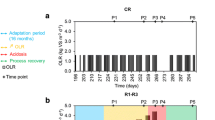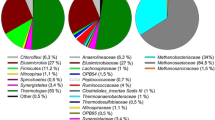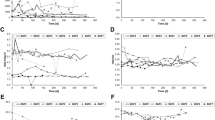Abstract
Anaerobic digestion of nitrogen-rich substrate often causes process inhibition due to the susceptibility of the microbial community facing ammonia accumulation. However, the precise response of the microbial community has remained largely unknown. To explore the reasons, bacterial communities in ammonia-stressed reactors and control reactors were studied by amplicon pyrosequencing of 16S rRNA genes and the active methanogens were followed by terminal restriction fragment length polymorphism (T-RFLP) analyses of mcrA/mrtA gene transcripts. The results showed that the diversity of bacterial communities decreased in two parallel ammonia-inhibited reactors compared with two control reactors, but different levels of inhibitions coinciding with different community shifts were observed. In one reactor, the process was completely inhibited, which was preceded by a decreasing relative abundance of the phylum Firmicutes. Despite the same operating conditions, the process was stabilized in the parallel, partially inhibited reactor, in which the relative abundance of Firmicutes greatly increased. In particular, both ammonia-inhibited reactors lacked taxa assumed to be syntrophic bacteria (Thermoanaerobacteraceae, Syntrophomonadaceae, and Synergistaceae). Besides the predominance of the hydrogenotrophic methanogens Methanoculleus and Methanobacterium, activity of Methanosarcina and even of the strictly aceticlastic genus Methanosaeta were found to contribute at very high ammonia levels (> 9 g NH4-N L−1) in the stabilized reactor (partial inhibition). In contrast, the lack of aceticlastic activity in the parallel reactor might have led to acetate accumulation and thus process failure (complete inhibition). Collectively, ammonia was found to be a general inhibitor while accumulating acetate and thus acidification might be the key factor of complete process failure.






Similar content being viewed by others
References
Amha YM, Anwar MZ, Brower A, Jacobsen CS, Stadler LB, Webster TM, Smith AL (2017) Inhibition of anaerobic digestion processes: applications of molecular tools. Bioresour Technol 247:999–1014. https://doi.org/10.1016/j.biortech.2017.08.210
Angelidaki I, Ellegaard L, Ahring BK (1993) A mathematical-model for dynamic simulation of anaerobic-digestion of complex substrates—focusing on ammonia inhibition. Biotechnol Bioeng 42(2):159–166. https://doi.org/10.1002/bit.260420203
Azman S, Khadem AF, Plugge CM, Stams AJ, Bec S, Zeeman G (2017) Effect of humic acid on anaerobic digestion of cellulose and xylan in completely stirred tank reactors: inhibitory effect, mitigation of the inhibition and the dynamics of the microbial communities. Appl Microbiol Biotechnol 101(2):889–901. https://doi.org/10.1007/s00253-016-8010-x
Bouanane-Darenfed A, Ben Hania W, Cayol JL, Ollivier B, Fardeau ML (2015) Reclassification of Acetomicrobium faecale as Caldicoprobacter faecalis comb. nov. Int J Syst Evol Microbiol 65(10):3286–3288. https://doi.org/10.1099/ijsem.0.000409
Briones A, Raskin L (2003) Diversity and dynamics of microbial communities in engineered environments and their implications for process stability. Curr Opin Biotechnol 14(3):270–276. https://doi.org/10.1016/S0958-1669(03)00065-X
Buhligen F, Lucas R, Nikolausz M, Kleinsteuber S (2016) A T-RFLP database for the rapid profiling of methanogenic communities in anaerobic digesters. Anaerobe 39:114–116. https://doi.org/10.1016/j.anaerobe.2016.03.013
Campanaro S, Treu L, Kougias PG, De Francisci D, Valle G, Angelidaki I (2016) Metagenomic analysis and functional characterization of the biogas microbiome using high throughput shotgun sequencing and a novel binning strategy. Biotechnol Biofuels 9:26. https://doi.org/10.1186/s13068-016-0441-1
Caporaso JGKJ, Stombaugh J, Bittinger K, Bushman FD, Costello EK, Fierer N, Peña AG, Goodrich JK, Gordon JI, Huttley GA, Kelley ST, Knights D, Koenig JE, Ley RE, Lozupone CA, McDonald D, Muegge BD, Pirrung M, Reeder J, Sevinsky JR, Turnbaugh PJ, Walters WA, Widmann J, Yatsunenko T, Zaneveld J, Knight R (2010) QIIME allows analysis of high-throughput community sequencing data. Nat Methods 7:335–336. https://doi.org/10.1038/nmeth.f.303
Carballa M, Regueiro L, Lema JM (2015) Microbial management of anaerobic digestion: exploiting the microbiome-functionality nexus. Curr Opin Biotechnol 33:103–111. https://doi.org/10.1016/j.copbio.2015.01.008
Caruso T, Chan Y, Lacap DC, Lau MC, McKay CP, Pointing SB (2011) Stochastic and deterministic processes interact in the assembly of desert microbial communities on a global scale. ISME J 5(9):1406–1413. https://doi.org/10.1038/ismej.2011.21
Chen Y, Cheng JJ, Creamer KS (2008) Inhibition of anaerobic digestion process: a review. Bioresour Technol 99(10):4044–4064. https://doi.org/10.1016/j.biortech.2007.01.057
De Vrieze J, Verstraete W (2016) Perspectives for microbial community composition in anaerobic digestion: from abundance and activity to connectivity. Environ Microbiol 18(9):2797–2809. https://doi.org/10.1111/1462-2920.13437
Dearman B, Marschner P, Bentham RH (2006) Methane production and microbial community structure in single-stage batch and sequential batch systems anaerobically co-digesting food waste and biosolids. Appl Microbiol Biotechnol 69(5):589–596. https://doi.org/10.1007/s00253-005-0076-9
Demirel B, Yenigün O (2002) Two phase anaerobic digestion processes: a review. J Chem Technol Biotechnol 77(7):743–755. https://doi.org/10.1002/jctb.630
Edgar RC (2010) Search and clustering orders of magnitude faster than BLAST. Bioinformatics 26(19):2460–2461. https://doi.org/10.1093/bioinformatics/btq461
Fernandez AS, Hashsham SA, Dollhopf SL, Raskin L, Glagoleva O, Dazzo FB, Hickey RF, Criddle CS, Tiedje JM (2000) Flexible community structure correlates with stable community function in methanogenic bioreactor communities perturbed by glucose. Appl Environ Microbiol 66(9):4058–4067. https://doi.org/10.1128/AEM.66.9.4058-4067.2000
Fotidis IA, Karakashev D, Kotsopoulos TA, Martzopoulos GG, Angelidaki I (2013) Effect of ammonium and acetate on methanogenic pathway and methanogenic community composition. FEMS Microbiol Ecol 83(1):38–48. https://doi.org/10.1016/j.biortech.2011.12.072
Frank JA, Arntzen MO, Sun L, Hagen LH, McHardy AC, Horn SJ, Eijsink VG, Schnurer A, Pope PB (2016) Novel syntrophic populations dominate an ammonia-tolerant methanogenic microbiome. mSystems 1(5). https://doi.org/10.1128/mSystems.00092-16
Gagnon N, Barret M, Topp E, Kalmokoff M, Masse D, Masse L, Talbot G (2011) A novel fingerprint method to assess the diversity of methanogens in microbial systems. FEMS Microbiol Lett 325(2):115–122. https://doi.org/10.1111/j.1574-6968.2011.02418.x
Gao SM, Zhao MX, Chen Y, Yu MJ, Ruan WQ (2015) Tolerance response to in situ ammonia stress in a pilot-scale anaerobic digestion reactor for alleviating ammonia inhibition. Bioresour Technol 198:372–379. https://doi.org/10.1016/j.biortech.2015.09.044
Garcia SL, Jangid K, Whitman WB, Das K (2011) Transition of microbial communities during the adaption to anaerobic digestion of carrot waste. Bioresour Technol 102(15):7249–7256. https://doi.org/10.1016/j.biortech.2011.04.098
Gregory RW, Bolker B, Bonebakker L, Gentleman R, Huber W, Liaw A, Lumley T, Maechler M, Magnusson A, Moeller S, Schwartz M, Venables B (2011) Gplots: various R programming tools for plotting data. R package version 2101 http://CRAN.R-project.org/package=gplots
Hagen LH, Frank JA, Zamanzadeh M, Eijsink VG, Pope PB, Horn SJ, Arntzen MO (2017) Quantitative metaproteomics highlight the metabolic contributions of uncultured phylotypes in a thermophilic anaerobic digester. Appl Environ Microbiol 83(2). https://doi.org/10.1128/AEM.01955-16
Hori T, Sasaki D, Haruta S, Shigematsu T, Ueno Y, Ishii M, Igarashi Y (2011) Detection of active, potentially acetate-oxidizing syntrophs in an anaerobic digester by flux measurement and formyltetrahydrofolate synthetase (FTHFS) expression profiling. Microbiology 157(7):1980–1989. https://doi.org/10.1099/mic.0.049189-0
Iino T, Tamaki H, Tamazawa S, Ueno Y, Ohkuma M, Suzuki K, Igarashi Y, Haruta S (2013) Candidatus Methanogranum caenicola: a novel methanogen from the anaerobic digested sludge, and proposal of Methanomassiliicoccaceae fam. nov and Methanomassiliicoccales ord. nov., for a methanogenic lineage of the class Thermoplasmata. Microbes Environ 28(2):244–250. https://doi.org/10.1264/jsme2.ME12189
Kadam PC, Boone DR (1996) Influence of pH on ammonia accumulation and toxicity in halophilic, Methylotrophic Methanogens. Appl Environ Microbiol 62(12):4486–4492
Karakashev D, Batstone DJ, Trably E, Angelidaki I (2006) Acetate oxidation is the dominant methanogenic pathway from acetate in the absence of Methanosaetaceae. Appl Environ Microbiol 72(7):5138–5141. https://doi.org/10.1128/AEM.00489-06
Leite AF, Janke L, Harms H, Richnow HH, Nikolausz M (2016) Lessons learned from the microbial ecology resulting from different inoculation strategies for biogas production from waste products of the bioethanol/sugar industry. Biotechnol Biofuels 9(144):144. https://doi.org/10.1186/s13068-016-0548-4
Li N, He J, Yan H, Chen SS, Dai XH (2017) Pathways in bacterial and archaeal communities dictated by ammonium stress in a high solid anaerobic digester with dewatered sludge. Bioresour Technol 241:95–102. https://doi.org/10.1016/j.biortech.2017.05.094
Lucas R, Kuchenbuch A, Fetzer I, Harms H, Kleinsteuber S (2015) Long-term monitoring reveals stable and remarkably similar microbial communities in parallel full-scale biogas reactors digesting energy crops. FEMS Microbiol Ecol 91(3). https://doi.org/10.1093/femsec/fiv004
Lv Z, Hu M, Harms H, Richnow HH, Liebetrau J, Nikolausz M (2014a) Stable isotope composition of biogas allows early warning of complete process failure as a result of ammonia inhibition in anaerobic digesters. Bioresour Technol 167:251–259. https://doi.org/10.1016/j.biortech.2014.06.029
Lv Z, Leite AF, Harms H, Richnow HH, Liebetrau J, Nikolausz M (2014b) Influences of the substrate feeding regime on methanogenic activity in biogas reactors approached by molecular and stable isotope methods. Anaerobe 29:91–99. https://doi.org/10.1016/j.anaerobe.2013.11.005
Lv ZP, Jiang JH, Liebetrau J, Richnow HH, Fischer A, Acs N, Nikolausz M (2018) Ammonium chloride vs urea-induced ammonia inhibition of the biogas process assessed by stable isotope analysis. Chem Eng Technol 41(4):671–679. https://doi.org/10.1002/ceat.201700482
Mathai PP, Zitomer DH, Maki JS (2015) Quantitative detection of syntrophic fatty acid-degrading bacterial communities in methanogenic environments. Microbiology 161(6):1189–1197. https://doi.org/10.1099/mic.0.000085
McDonald D, Price MN, Goodrich J, Nawrocki EP, DeSantis TZ, Probst A, Andersen GL, Knight R, Hugenholtz P (2012) An improved Greengenes taxonomy with explicit ranks for ecological and evolutionary analyses of bacteria and archaea. ISME J 6(3):610–618. https://doi.org/10.1038/ismej.2011.139
Mosbaek F, Kjeldal H, Mulat DG, Albertsen M, Ward AJ, Feilberg A, Nielsen JL (2016) Identification of syntrophic acetate-oxidizing bacteria in anaerobic digesters by combined protein-based stable isotope probing and metagenomics. ISME J 10(10):2405–2418. https://doi.org/10.1038/ismej.2016.39
Nikolausz M, Walter RFH, Sträuber H, Liebetrau J, Schmidt T, Kleinsteuber S, Bratfisch F, Günther U, Richnow HH (2013) Evaluation of stable isotope fingerprinting techniques for the assessment of the predominant methanogenic pathways in anaerobic digesters. Appl Microbiol Biotechnol 97(5):2251–2262. https://doi.org/10.1007/s00253-012-4657-0
Nobu MK, Narihiro T, Rinke C, Kamagata Y, Tringe SG, Woyke T, Liu WT (2015) Microbial dark matter ecogenomics reveals complex synergistic networks in a methanogenic bioreactor. ISME J 9(8):1710–1722. https://doi.org/10.1038/ismej.2014.256
Poirier S, Desmond-Le Quemener E, Madigou C, Bouchez T, Chapleur O (2016) Anaerobic digestion of biowaste under extreme ammonia concentration: identification of key microbial phylotypes. Bioresour Technol 207:92–101. https://doi.org/10.1016/j.biortech.2016.01.124
Ruiz-Sanchez J, Campanaro S, Guivernau M, Fernandez B, Prenafeta-Boldu FX (2018) Effect of ammonia on the active microbiome and metagenome from stable full-scale digesters. Bioresour Technol 250:513–522. https://doi.org/10.1016/j.biortech.2017.11.068
Schink B (1997) Energetics of syntrophic cooperation in methanogenic degradation. Microbiol Mol Biol Rev 61(2):262–280
Schnürer A, Nordberg Å (2008) Ammonia, a selective agent for methane production by syntrophic acetate oxidation at mesophilic temperature. Water Sci Technol 57(5):735–740. https://doi.org/10.2166/wst.2008.097
Schnürer A, Schink B, Svensson BH (1996) Clostridium ultunense sp. nov., a mesophilic bacterium oxidizing acetate in syntrophic association with a hydrogenotrophic methanogenic bacterium. Int J Syst Bacteriol 46(4):1145–1152. https://doi.org/10.1099/00207713-46-4-1145
Schnürer A, Zellner G, Svensson BH (1999) Mesophilic syntrophic acetate oxidation during methane formation in biogas reactors. FEMS Microbiol Ecol 29(3):249–261. https://doi.org/10.1111/j.1574-6941.1999.tb00616.x
Schwarz W (2001) The cellulosome and cellulose degradation by anaerobic bacteria. Appl Microbiol Biotechnol 56(5–6):634–649. https://doi.org/10.1007/s002530100710
Solli L, Havelsrud OE, Horn SJ, Rike AG (2014) A metagenomic study of the microbial communities in four parallel biogas reactors. Biotechnol Biofuels 7:14. https://doi.org/10.1186/s13068-014-0146-2
Steinberg LM, Regan JM (2008) Phylogenetic comparison of the methanogenic communities from an acidic, oligotrophic fen and an anaerobic digester treating municipal wastewater sludge. Appl Environ Microbiol 74(21):6663–6671. https://doi.org/10.1128/AEM.00553-08
Sun C, Cao WX, Banks CJ, Heaven S, Liu RH (2016a) Biogas production from undiluted chicken manure and maize silage: a study of ammonia inhibition in high solids anaerobic digestion. Bioresour Technol 218:1215–1223. https://doi.org/10.1016/j.biortech.2016.07.082
Sun L, Liu T, Muller B, Schnurer A (2016b) The microbial community structure in industrial biogas plants influences the degradation rate of straw and cellulose in batch tests. Biotechnol Biofuels 9:128. https://doi.org/10.1186/s13068-016-0543-9
Sundberg C, Al-Soud WA, Larsson M, Alm E, Yekta SS, Svensson BH, Sørensen SJ, Karlsson A (2013) 454 pyrosequencing analyses of bacterial and archaeal richness in 21 full-scale biogas digesters. FEMS Microbiol Ecol 85(3):612–626. https://doi.org/10.1111/1574-6941.12148
Vanwonterghem I, Jensen PD, Dennis PG, Hugenholtz P, Rabaey K, Tyson GW (2014) Deterministic processes guide long-term synchronised population dynamics in replicate anaerobic digesters. ISME J 8:1–14. https://doi.org/10.1038/ismej.2014.50
Wang Q, Garrity GM, Tiedje JM, Cole JR (2007) Naive Bayesian classifier for rapid assignment of rRNA sequences into the new bacterial taxonomy. Appl Environ Microbiol 73(16):5261–5267. https://doi.org/10.1128/AEM.00062-07
Wang H, Fotidis IA, Angelidaki I (2015) Ammonia effect on hydrogenotrophic methanogens and syntrophic acetate-oxidizing bacteria. FEMS Microbiol Ecol 91(11). https://doi.org/10.1093/femsec/fiv130
Werner JJ, Garcia ML, Perkins SD, Yarasheski KE, Smith SR, Muegge BD, Stadermann FJ, DeRito CM, Floss C, Madsen EL, Gordon JI, Angenent LT (2014) Microbial community dynamics and stability during an ammonia-induced shift to syntrophic acetate oxidation. Appl Environ Microbiol 80(11):3375–3383. https://doi.org/10.1128/AEM.00166-14
Westerholm M, Moestedt J, Schnurer A (2016) Biogas production through syntrophic acetate oxidation and deliberate operating strategies for improved digester performance. Appl Energy 179:124–135. https://doi.org/10.1016/j.apenergy.2016.06.061
Westerholm M, Muller B, Singh A, Karlsson Lindsjo O, Schnurer A (2018) Detection of novel syntrophic acetate-oxidizing bacteria from biogas processes by continuous acetate enrichment approaches. Microb Biotechnol 11(4):680–693. https://doi.org/10.1111/1751-7915.13035
Zaneveld JR, McMinds R, Thurber RV (2017) Stress and stability: applying the Anna Karenina principle to animal microbiomes. Nat Microbiol 2(9). https://doi.org/10.1038/nmicrobiol.2017.121
Zhang C, Yuan Q, Lu Y (2014) Inhibitory effects of ammonia on methanogen mcrA transcripts in anaerobic digester sludge. FEMS Microbiol Ecol 87(2):368–377. https://doi.org/10.1111/1574-6941.12229
Zhou JZ, Liu WZ, Deng Y, Jiang YH, Xue K, He ZL, Van Nostrand JD, Wu LY, Yang YF, Wang AJ (2013) Stochastic assembly leads to alternative communities with distinct functions in a bioreactor microbial community. Mbio 4(2):e00584–e00512. https://doi.org/10.1128/mBio.00584-12.
Ziganshin AM, Liebetrau J, Pröter J, Kleinsteuber S (2013) Microbial community structure and dynamics during anaerobic digestion of various agricultural waste materials. Appl Microbiol Biotechnol 97(11):5161–5174. https://doi.org/10.1007/s00253-013-4867-0
Acknowledgements
We would like to thank Ute Lohse for technical assistance during pyrosequencing.
Funding
The work was supported by the National Natural Science Foundation of China (grant number 51708264) and Initiative and Networking Fund of the Helmholtz Association. Dr. Zuopeng Lv was supported by the China Scholarship Council (grant number 2011642040).
Author information
Authors and Affiliations
Corresponding author
Ethics declarations
Conflict of interest
The authors declare that they have no conflict of interest.
Ethical approval
This article does not contain any studies with human participants or animals performed by any of the authors.
Electronic supplementary material
ESM 1
(PDF 1113 kb)
Rights and permissions
About this article
Cite this article
Lv, Z., Leite, A.F., Harms, H. et al. Microbial community shifts in biogas reactors upon complete or partial ammonia inhibition. Appl Microbiol Biotechnol 103, 519–533 (2019). https://doi.org/10.1007/s00253-018-9444-0
Received:
Revised:
Accepted:
Published:
Issue Date:
DOI: https://doi.org/10.1007/s00253-018-9444-0




